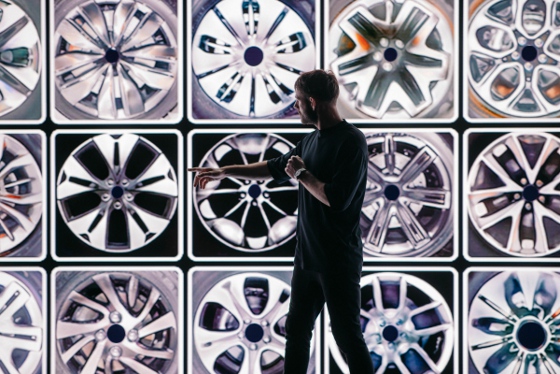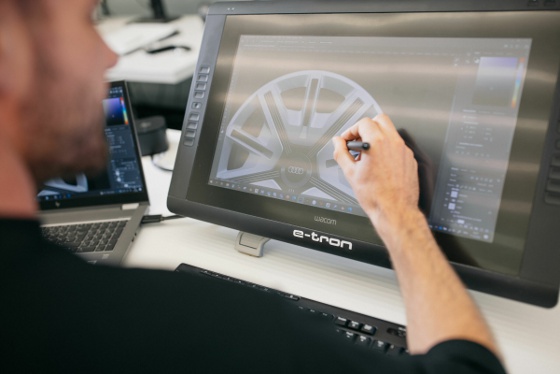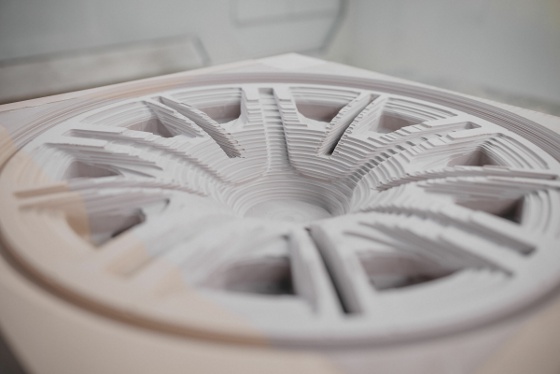 |
| January 31, 2023 | Volume 19 Issue 04 |
Designfax weekly eMagazine
Archives
Partners
Manufacturing Center
Product Spotlight
Modern Applications News
Metalworking Ideas For
Today's Job Shops
Tooling and Production
Strategies for large
metalworking plants
Audi using AI to invent new rim designs

Using FelGAN software, AI meets design at Audi. [Credit: Copyright AUDI AG]
Inspiration can come from almost anywhere. At global automaker Audi, designers are tapping in-house-developed artificial intelligence (AI) software called FelGAN to draw from an almost unlimited pool of ideas for new wheel designs.
The name "FelGAN" is a mash-up of the German word for "rim" (Felge) and "GAN," an acronym for Generative Adversarial Networks. GANs are a special form of self-learning computer program in which two algorithms compete as opponents during the so-called training, becoming better and better in competition with each other.
According to Audi, "FelGAN works either by rapidly proposing a large number of photo-realistic designs itself or recombining existing designs in a targeted way." The system acts as a kind of spontaneous idea hub for Audi's rim design team, allowing them to mash up new versions and variations. The tool lets designers easily experiment with shape, color, surface structure, and other parameters in real time.
FelGAN was developed and implemented in an entirely in-house collaboration between Audi's IT and design departments. It's a form of generative design, which uses cloud computing and AI-based algorithms to explore multiple part designs rapidly.

Besides skill, a creative perspective and experience play a key role in successfully utilizing the new FelGAN AI tools and process. [Credit: Copyright AUDI AG]
The initial training process for the system works like this: One of the two algorithms, the "generator," makes artificial images of a specific motif, which in the case of FelGAN is a vehicle rim. The other algorithm acts as a discriminator (kind of like an umpire or decider) that sees a selection of images, consisting of real wheel photos alongside images from the generator. Now the discriminator decides whether each image is a creation of the generator or a real photo. This process is repeated again and again until training is completed, building in "realness" (or in some cases feasibility) as it progresses.
Both algorithms are designed to learn from their mistakes and improve continuously. Audi says that after enough runs, the generator's creations are so deceptively real that the human eye can often not distinguish them from real photos.
The application's intuitive user interface, which is based on Streamlit technology, creates short development cycles and quick feedback between the design and IT team. The designers do not have to rely on high-performance local hardware when using the software solution because the components of the AI application, which require a lot of processing power, are run in the cloud.
Another benefit of FelGAN is that the software assigns a mathematical value to each design that the AI makes. Referred to by developers as "DNA," these values can be used at any time to reproduce designs. But that's not all. Audi designers can also feed the program with their own designs and photos, adding them to the virtual experimental surface. This is based on special algorithms that determine the appropriate DNA values for the images that designers input.
Often, designers only go on to use small, individual elements from FelGAN's creations, refining them into a harmonious overall design. In addition to mastery of the tools of the trade, a creative eye and professional experience play a decisive role in using the system. Finally, the experts at Audi make the virtual design a reality by producing a prototype of the wheel, either in plastic or aluminum, using a high-tech milling machine.

The Audi wheel designs can become reality quickly in a milled prototype. [Credit: Copyright AUDI AG]
In the future, the technology behind FelGAN could be expanded into a comprehensive AI design platform that could also serve as a source of inspiration for designers from other Audi departments. Furthermore, an AI rating system is currently being developed in which each rim generated by FelGAN will be assessed for its carbon balance.
Source: Audi
Published January 2023
Rate this article
View our terms of use and privacy policy
